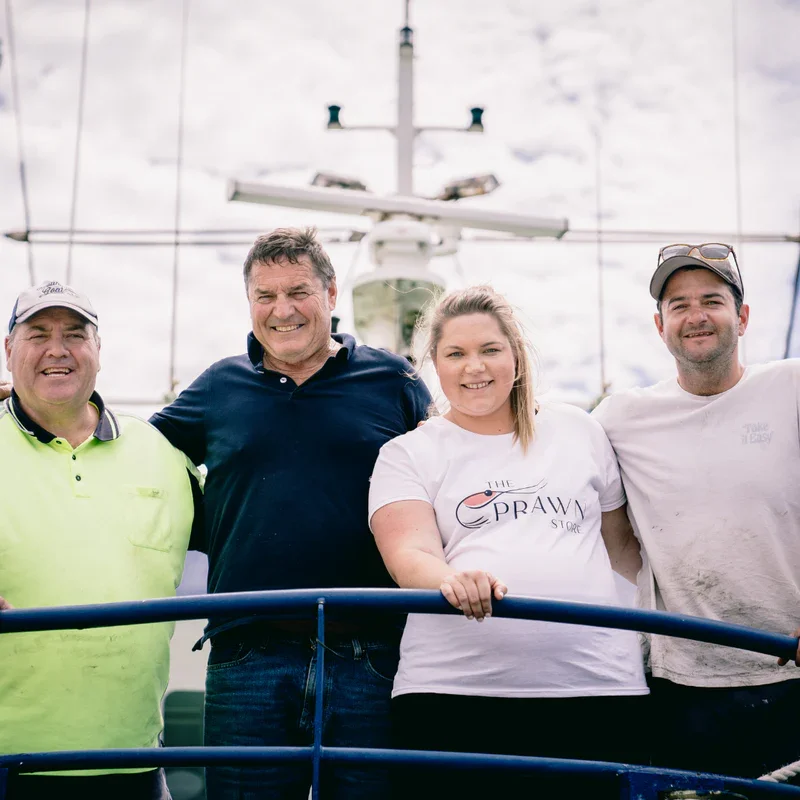Legacy in the Gulf: The Tapley Family and Australia’s Most Sustainable Prawn Fishery
A fishing family with a 35-year legacy working in the most sustainable prawn fishery in Australia.
— The Tapley Family
A Life Shaped by the Gulf
The Tapley family’s legacy in fishing spans three generations, deeply rooted in the waters of Spencer Gulf and the surrounding Eyre Peninsula. Anne and Graham Tapley, together with their children Joe and Meghan, have dedicated their lives to the sea, building a reputation for skill, resilience, and stewardship. For over 35 years, the Tapleys have worked these waters, adapting to changing times and opportunities while remaining true to their values.
Historically, the family has been involved in a range of fisheries—rock lobster, shark, and tuna longline—reflecting the diversity and richness of South Australia’s marine environment. Their experience across these sectors has shaped a deep understanding of the Gulf’s rhythms and the importance of sustainable practice. In recent years, the Tapleys have focused their efforts on the prized Spencer Gulf King Prawn, securing a coveted licence in one of Australia’s most tightly managed and respected fisheries.
Practice: What They Do and How They Do It
The Tapleys’ approach to prawn fishing is defined by precision, restraint, and a commitment to sustainability. The Spencer Gulf King Prawn fishery is globally recognised for its world-first achievements: it was the first king prawn fishery in the world, and the first prawn fishery in Asia–Pacific, to achieve Marine Stewardship Council (MSC) certification in 2011. Australia’s 2023 status report continues to classify its stock as “sustainable.”
This fishery is unique in its management. Only 39 double-rigged trawlers are licensed to operate, and the fleet typically fishes just 50 nights per year, covering less than 20% of the Gulf’s waters. This deliberate limitation leaves the majority of the habitat untouched each season, allowing ecosystems to recover and thrive. Over the past 40 years, fishing effort has been cut by about 60%—a conscious decision to maintain ecological balance rather than chase maximum catch.
Innovation is central to the fishery’s success. The adoption of Nordmøre-grid bycatch reduction devices has allowed up to 34% of blue swimmer crabs and cuttlefish to escape while maintaining prawn catch, reducing impacts on iconic species like the giant cuttlefish. Sourcing directly from a validated Spencer Gulf fisher means buyers are not supporting fisheries with substantial bycatch, including threatened, endangered, and protected species—a distinction that sets this fishery apart from many others in Australia.
Provenance and Plate
The Prawn Store, operated by the Tapley family, is the direct link between the Gulf and the plate. Every prawn is sourced from their own boats, ensuring a 100% South Australian product delivered from their family to yours. This transparent supply chain is a point of pride, offering chefs and buyers confidence in the provenance, quality, and sustainability of every catch.
Systems and Regeneration
Dynamic management is at the heart of the Spencer Gulf King Prawn fishery. Fishing dates and closures are adjusted in real time, based on harvests and environmental conditions. Rigorous bycatch and byproduct controls, combined with adaptive management, ensure the fishery remains resilient and future-focused.
The Tapley family’s story is one of intergenerational stewardship, traceability, and a deep respect for the marine environment. Their legacy is not just in the prawns they land, but in the knowledge, restraint, and care they bring to every season.
The Tapley family’s journey is a testament to the power of knowledge, restraint, and adaptation. In the Spencer Gulf, every prawn tells a story of place, people, and a future that honours both. For chefs seeking provenance, quality, and a genuine connection to the source, The Prawn Store offers more than just seafood—it offers a legacy.
Key Stats
World-first eco-labelled prawns. The Spencer Gulf king prawn fishery has been MSC-certified since 2011 and was the first king prawn fishery in the world (and first prawn fishery in Asia–Pacific) to meet the Marine Stewardship Council standard; Australia’s 2023 status report also classifies its stock as “sustainable.” (MSC Fisheries)
Tightly limited footprint. The fleet of 39 double-rigged trawlers usually fishes only ~50 nights per year and works in less than 20% of Spencer Gulf, leaving most of the habitat unfished each season. (PLOS One)
Deliberate effort reduction. Fishing effort in the Spencer Gulf prawn fishery has been cut by about 60% over the past 40 years through management decisions, rather than chasing maximum catch, to keep the fishery within ecological limits. (PLOS One)
Active bycatch and welfare measures. Trials of Nordmøre-grid bycatch-reduction devices allowed up to 34% of blue swimmer crabs and cuttlefish to escape while maintaining prawn catch, part of an ongoing program to reduce impacts on iconic species like giant cuttlefish. (PLOS One)
Food and regional livelihoods. Spencer Gulf is Australia’s largest producer of western king prawns, and in 2006/07 the Spencer Gulf and West Coast prawn fisheries contributed about $56.9 million to South Australia’s economy and supported around 217 full-time-equivalent jobs, connecting family fishing businesses directly to domestic and export food markets. (The Fishery)





